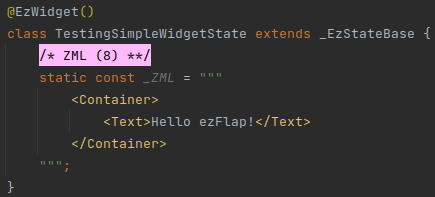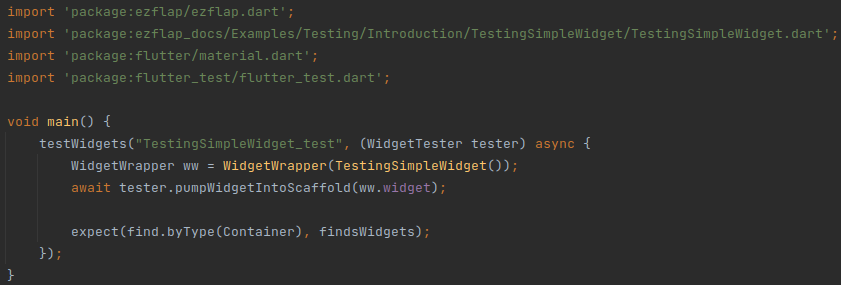# Introduction
# Overview
ezFlap offers several classes and utilities on top of Flutter's built-in component testing framework, to help testing ezFlap widgets.
These allow to:
- Initialize ezFlap widgets with props, models, and route parameters.
- Mock services and hosted widgets.
- Test emits, models, and service method calls.
ezFlap widgets can be tested like native Flutter widgets, but in order to initialize, mock, and access ezFlap-specific capabilities - we use ezFlap's WidgetWrapper class.
# Widget Wrapper
ezFlap's WidgetWrapper class wraps around an ezFlap widget, and provides a convenient interface to interact with the ezFlap capabilities implemented by the widget (such as props, emits, etc).
The simplest use-case is wrapping a widget without providing props or other data to it.
Consider the following widget:

It can be wrapped in a WidgetWrapper class and used in a test like this:
All the capabilities of the WidgetWrapper class will be covered in the following chapters.

PUMP WIDGET INTO SCAFFOLD
The above example uses the ezFlap pumpWidgetIntoScaffold() utility function.
This function wraps around Flutter's WidgetTester.pumpWidget, and creates a MaterialApp and Scaffold around the
tested widget.
This, and other utilities are covered in full detail below.
# Extension Methods on WidgetTester
The below extension methods are applied to Flutter's WidgetTester class.
# pumpWidgetIntoScaffold
# Signature
Future<void> pumpWidgetIntoScaffold(Widget widget, [ bool withExtraTick = true ]) async
# Description
Creates a MaterialApp and Scaffold widgets, and passes widget to the body parameter of the Scaffold.
By default, pumps a single tick (by calling WidgetTester.pump() with a Duration of zero milliseconds).
# pumpTick
# Signature
Future<void> pumpTick() async {
# Description
Pumps a single tick by calling WidgetTester.pump() with a Duration of zero milliseconds.
# pumpWithMilliseconds
# Signature
Future<void> pumpWithMilliseconds(int milliseconds) async
# Description
Pumps milliseconds milliseconds.
# pumpWithSeconds
# Signature
Future<void> pumpWithSeconds(int seconds) async
# Description
Pumps seconds seconds.
# pumpWithSecondsPlusTick
# Signature
Future<void> pumpWithSecondsPlusTick(int seconds) async
# Description
Pumps seconds seconds, and then pumps another tick.
This is useful because in some cases, the UI may require an additional tick to update after some reactive data changes.
# tapAndTick
# Signature
Future<void> tapAndTick(String key) async
# Description
Finds a widget by a string key (e.g. that was provided in the ZML with a key attribute), taps on it, and pumps a tick.
# tapAndTickByFinder
# Signature
Future<void> tapAndTickByFinder(Finder finder) async
# Description
Taps finder and then pumps a single tick (so that z-on handlers will get invoked).
# setScreenDimensions
# Signature
void setScreenDimensions(double width, double height)
# Description
Sets the dimensions of the virtual test viewport.
# multiplyScreenDimensionsBy
# Signature
void multiplyScreenDimensionsBy(double widthFactor, double heightFactor)
# Description
Multiplies the dimensions of the viewport by the provided factors.
# multiplyScreenWidthBy
# Signature
void multiplyScreenWidthBy(double factor)
# Description
Multiplies the width of the viewport by factor.
# multiplyScreenHeightBy
# Signature
void multiplyScreenHeightBy(double factor)
# Description
Multiplies the height of the viewport by factor.